With Windows Server 2012 has Microsoft Storage Spaces introduced. This is virtual memory, which may extend over several physical disks. The course is based on storage pools (storage pools), which in turn on each physical disk of a server aufbauen.
‘);}googletag.cmd.push(function(){googletag.display(“div-gpt-ad-DESKTOP_IN_ARTICLE-0″);});document.write(‘
‘);}})(jQuery);
The advantage of this is that administrators can easily increase the storage space by integrating more physical disks in the system. During this procedure, no new shares have not yet created data is copied, everything runs in the background, is scalable, fail-safe and powerful.
With Windows Server 2016, these opportunities are expanded and distributed to other servers. The new server version allows the expansion of storage spaces on physical disks from multiple servers in a cluster.

Storage Spaces with Windows Server 2012 and Windows Server 2012 R2 – SSD embed
With Windows Server 2012 R2 Microsoft Storage Spaces has expanded and offers the possibility of using this technology fast SSD to mix with conventional hard disks. The technology continues to be supported in Windows Server 2016, together with the new technology “Storage Spaces Direct”.
Windows detects files that are frequently in use and stores them automatically in the SSD field of Storage Space. Less files used to be outsourced to the slow hard disks. Of course, administrators can also manually control should be what kind of files on fast disks are available and what can be outsourced on slow disks. This technique is called Storage Tiers
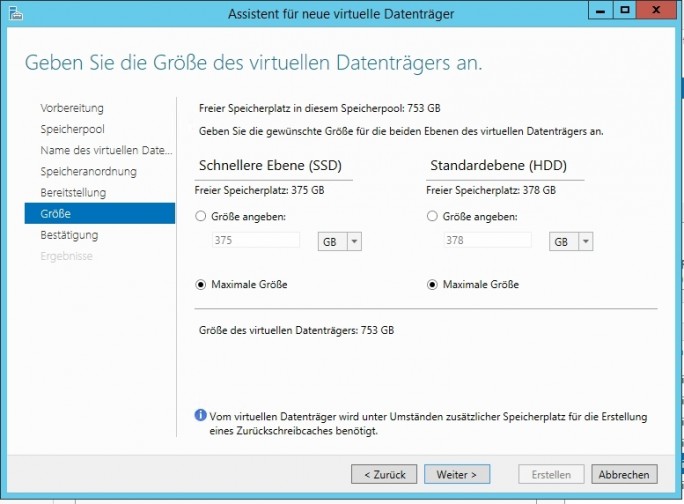 From Windows Server 2012 R2 can companies HDD and SSD mix with each other to ensure optimal performance in the Storage Space (Screenshot: Thomas Joos ).
From Windows Server 2012 R2 can companies HDD and SSD mix with each other to ensure optimal performance in the Storage Space (Screenshot: Thomas Joos ).
In addition to offering easy management and better performance Storage Spaces as well as more reliability. Because administrators can configure different redundancy and performance options for the various storage spaces. In addition, hot spare and hot-plug scenarios can be implemented with the technology easier than with conventional systems. Storage Spaces can also be combined with hardware RAID systems and SANs, also with respect to the redundancy of the individual storage space.
Storage Spaces expand with Windows Server 2016 further
With Windows Server 2016 Microsoft goes so one step further. The single volume of storage space no longer need to reside on the local server, but can also be connected to different servers. This feature allows software-defined storage capabilities that were previously not possible in this form with Windows servers. This technique is officially called Space Storage Direct.
Based on a Storage Space administrators can create with Disk Management in Windows Server 2016 traditional volumes. These behave on the servers as local drives, but build on the Storage Space on. The Storage Space in turn used physical disks, which can be distributed on different servers, for example, at the various nodes of a cluster.
Microsoft built into Windows Server 2016. In addition the possibility complete hard drives, even within a Storage pools, to replicate to other servers. This replication is done synchronously and block-based. Companies obtained in this way the possibility of geo-cluster build. These clusters cluster nodes all over the world are distributed. This guarantees consistent data exists, the data of the cluster must be replicated. These Windows Server 2016 is the first server version of Microsoft into the situation.
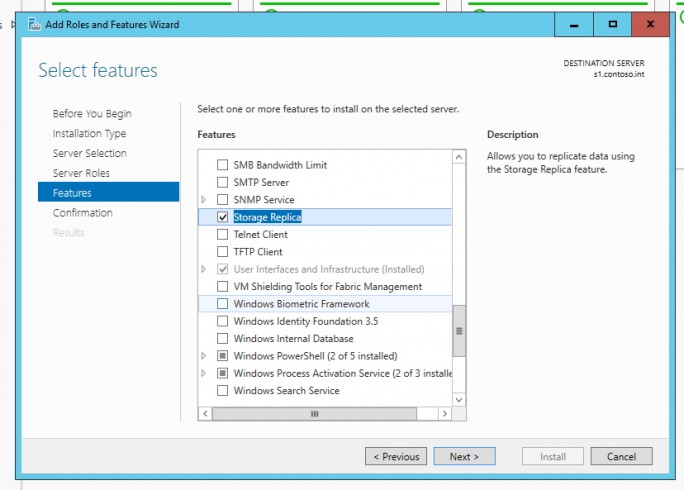 In Windows Server 2016 can be hard disks between servers operate together and also between servers replicate (Screenshot: Thomas Joos).
In Windows Server 2016 can be hard disks between servers operate together and also between servers replicate (Screenshot: Thomas Joos). As of Windows Server 2016, it is no longer necessary that each node of a Windows cluster are physically connected to the disk. Therefore now let various systems and hard drives standard mix with each other.
Another advantage of Storage Space Direct support of nano-servers running Windows Server 2016. Administrators can in this way clusters based on Nano build servers and create very small but efficient Hyper-V cluster. Once the cluster is set up, the function can be activated in the PowerShell with Enable Cluster Storage Space Direct .
Storage Spaces Direct use in production environments, companies need special hardware, especially compatible network cards that dominate RDMA. In test environments but can also be virtual server, use virtual hard disks and virtual NICs without special hardware.
Hyper-V in direct competition with VMware Virtual SAN
With Storage Spaces Direct Microsoft competes with VMware Virtual SAN. Again drives can be distributed across multiple servers. The focus of this technology are mainly virtualization environments. The shared memory of a cluster for Hyper-V can now therefore be replicated to different locations and cover the more Locations and Subsidiaries.
In addition, the locations of the virtual disks of the VMs of a Hyper-V cluster provide no single Point-of-Failure is more, if they are positioned on a Storage Space Direct, whose hard drives also replicate on different servers. On this basis, VMs can not only save, but companies can use Hyper-V Replication along with Storage Spaces Direct and Volume Replication. As the NTFS file system or rather the refs file system should be used. This is more stable and already prepared for Storage Spaces.
In such a structure can be realized common disk, without that there is a common data store in the cluster are, when all servers are connected. Each server has its own local disks, which in turn are connected to a Storage Space Direct and stand in the cluster. The data is replicated between servers. However, only Windows Server 2016 is given in the situation. The data exchange takes place not network protocols, but with SMB. 3
In this section, Windows Server 2016 also provides improved version of RDMA. With this technology, the memory of Windows servers can be replicated over the network. This only works with compatible network cards. The data traffic takes place in parallel with multiple SMB connections. Of course, the network at this point should be relatively performant.
Storage Spaces Direct with Windows Server 2016 TP test and prepare
Storage Spaces Direct with Windows Server testing 2016 administrators need an Active Directory domain, ideally in a test environment. The easiest way to test is that a Hyper-V host-based Windows Server 2016 SP3 installed. On this host four VMs are created, in turn, provide a cluster with Storage Spaces Direct. Here Generation 2 VMs based on a Hyper-V hosts with Windows Server should be used 2016th Prerequisite is the operation of Windows Server 2016 in the VMs on the host can generally also Windows Server 2012 R2 will be installed. Microsoft plans in the future to support scenarios with fewer nodes, but at least four nodes are currently needed.
On the four VMs administrators install Windows Server 2016. In addition, every VM to access the virtual switch of Hyper -V hosts are given, so that the VMs can communicate with one another and to the network. In addition, each VM must be allocated in addition to the system disk at least two virtual disks. The hard drives are assigned as VHDX file the virtual SCSI controllers. Use administrators a generation 2-VM, Hyper-V automatically integrates a virtual SCSI controller with a hard disk for the operating system. The two additional hard drives can be used as carriers for Storage Space Direct.
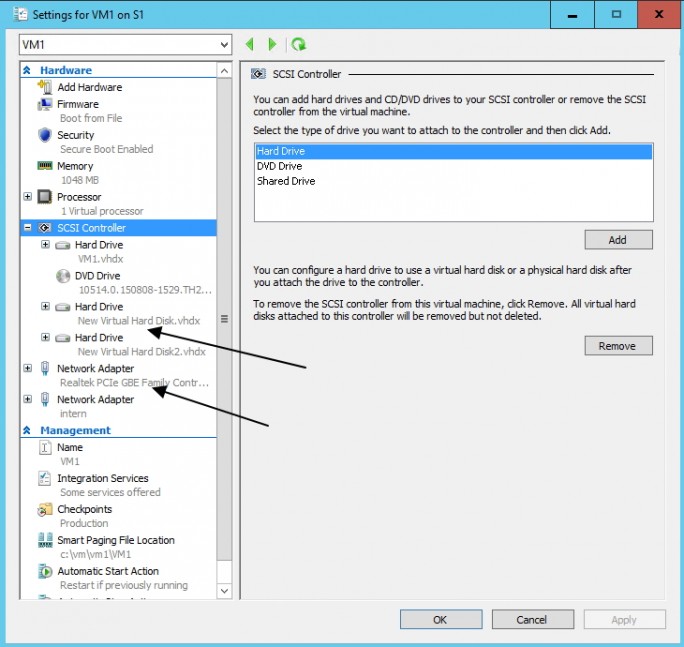 Test VMs for Storage Spaces Direct need access to three virtual hard disks and two virtual NICs (Screenshot: Thomas Joos).
Test VMs for Storage Spaces Direct need access to three virtual hard disks and two virtual NICs (Screenshot: Thomas Joos). In addition, administrators can create on the Hyper-V host another virtual switch with the status “Internal”. This switch is also assigned to each virtual server. These switches are used for communication of VMs among themselves and with the Hyper-V host.
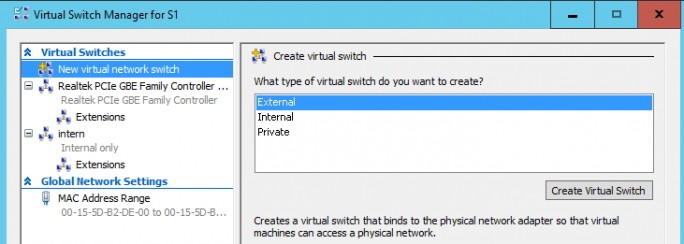 Virtual servers in the test environment can be assigned multiple virtual NICs, so that communication with Storage Spaces Direct works (Screenshot: Thomas Joos).
Virtual servers in the test environment can be assigned multiple virtual NICs, so that communication with Storage Spaces Direct works (Screenshot: Thomas Joos). to operate the simplest configuration to StorageSpace Direct, so is a Hyper-V host with four virtual servers and two virtual disks. Of course, even more virtual disks can be used, two are the minimum requirement for the operation.
Required roles and features for Storage Spaces Direct Install
On all servers, the member of the cluster for Storage Spaces Direct are intended, administrators need to install the server role file server and cluster features. The easiest way is in PowerShell using the command:
Install-WindowsFeature -name file services, failover clustering -IncludeManagementTools
In addition to the Disk Management, the hard disks for Storage Spaces Direct as online and appear initialized. Partitions are not created. After installation, the role and the cluster features and initialize the hard drives, the server can be restarted – but that they do not have. If a restart is necessary, the appropriate message.
 In the PowerShell the necessary conditions for Storage Spaces Direct to install (Screenshot: Thomas Joos).
In the PowerShell the necessary conditions for Storage Spaces Direct to install (Screenshot: Thomas Joos). Cluster for Storage Spaces Direct prepare and install
In the next step, the cluster nodes are supported in PowerShell on Cluster capability and support for Storage Spaces Direct. The command to do this is as follows:
test cluster -Node & lt; node1, node2, node3, node4 & gt; -Include “Storage Spaces Direct”, Inventory, Network, “System Configuration”
Here carry administrators the names of the four nodes. The review is to be launched on a single node, the test configuration and support for Storage Spaces Direct on all other nodes on the network.
First, the name resolution should be examined with nslookup to ensure that the test can reach all cluster nodes. In test environments warnings are irrelevant, since they do not prevent the installation of the cluster. Only error may not appear. In production environments the warnings should be naturally followed, so that the performance of the cluster is not affected.
If the test for all four nodes was successfully completed, will be made following the cluster. Cluster Name & gt;
New Cluster -Name & lt;: Again, the PowerShell is best used -Node & Lt; node1, node2, node3, node4 & gt; -NoStorage
working with DHCP to assign the cluster to test and in many production environments. If a static IP address to be used, the command:
New Cluster -Name & lt; Cluster Name & gt; -Node & Lt; node1, node2, node3, node4 & gt; -NoStorage -StaticAddress & Lt; XXXX & gt;
cluster check after creating and Storage Spaces Direct
After the cluster has been created, shows the PowerShell on the name of the cluster. In the test environment warning messages can be ignored. In practice, administrators should check the log file.
The next step will be displayed with Get-Cluster Network the networks in the cluster. The PowerShell needs networks to connect the cluster nodes (clusters) and for connecting to the Internet show. Storage Space Direct is finally activated with the cmdlet Enable Cluster Storage Space Direct . The command should show no errors
 In the PowerShell of clusters are created and Storage Spaces Direct enabled (Screenshot: Thomas Joos).
In the PowerShell of clusters are created and Storage Spaces Direct enabled (Screenshot: Thomas Joos).
About the Failover Cluster Manager can manage the cluster already. Here all nodes should appear and be functional.
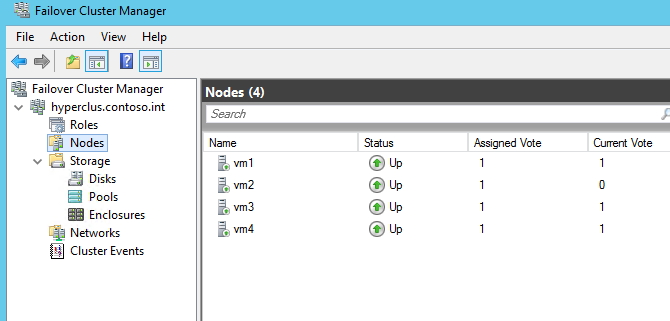 Check In Failover Cluster Manager administrators the function of the cluster (Screenshot: Thomas Joos).
Check In Failover Cluster Manager administrators the function of the cluster (Screenshot: Thomas Joos). Enter administrators on a cluster node in the PowerShell command Get-Physical Disk a, are all hard drives all cluster nodes appear as well as the information that they are capable of pool. The hard drives can to not have their own partitions.
 In Storage Spaces Direct clusters the hard drives of all connected disks are on the cluster nodes appear (Screenshot: Thomas Joos).
In Storage Spaces Direct clusters the hard drives of all connected disks are on the cluster nodes appear (Screenshot: Thomas Joos). Storage Pools and Storage Spaces Create
The cluster within a cluster with Storage Spaces Direct initially has no common data store. Once the cluster created, and Storage Spaces Direct is activated, the necessary storage pool is created, and then the Storage Spaces.
Here it is also possible in physical environments create storage tiers. It is to the aforementioned mixing SSDs and HDDs. In test environments but that is not necessary. Here is sufficient to create a single storage pool. Administrators have the ability to create a storage pool in the PowerShell or the Failover Cluster Manager on the field Storage Pools .
 Storage Pools can be in failover Create Cluster Manager (screenshot: Thomas Joos).
Storage Pools can be in failover Create Cluster Manager (screenshot: Thomas Joos). In the PowerShell syntax is:
New Storage Pool -StorageSubSystemName & lt; gt FQDN of the subsystem &; -FriendlyName & Lt; Storage Pool Name & gt; -WriteCacheSizeDefault 0 -FaultDomainAwarenessDefault Storage Scale Unit -ProvisioningTypeDefault Fixed -ResiliencySettingNameDefault Mirror -PhysicalDisk (Get-Storage Subsystem -Name & lt; FQDN of the subsystem & gt; | Get-Physical Disk)
As soon as the storage pool is displayed in the cluster , administrators can use the context menu of the pools in the Failover Cluster Manager New Virtual Hard Disk, also called Storage Spaces, create. The wizard can also specify the availability and the storage layout of the new Storage Space. This builds on the established storage pool.
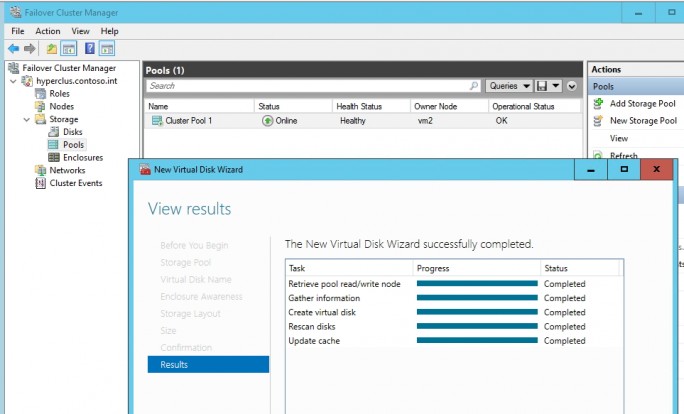 On the basis of a storage pool, a virtual disk (Storage Space) is created, which in turn builds on the individual physical disks of the cluster nodes ( Screenshot:. Thomas Joos)
On the basis of a storage pool, a virtual disk (Storage Space) is created, which in turn builds on the individual physical disks of the cluster nodes ( Screenshot:. Thomas Joos) scale-out file servers create
About the wizard to create new clusters roles allow administrators to a new Create scale-out file servers in the cluster. Once this is available, and access points were set up shares on the server can be made available.
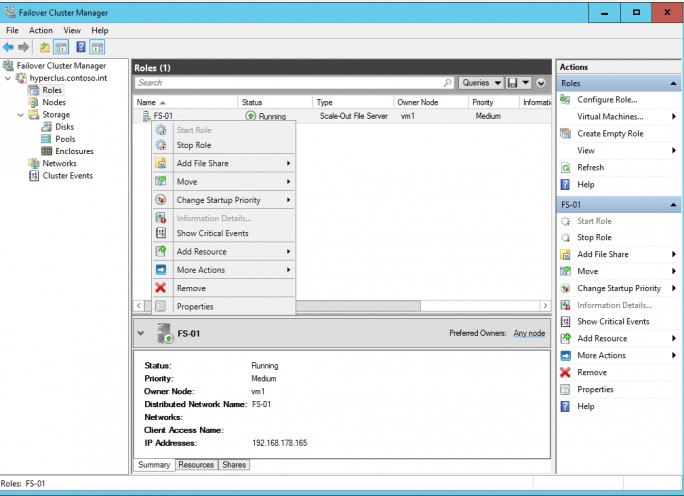 About a new scale-out file servers can be clearances create that to Storage Spaces Direct build (Screenshot: Thomas Joos )
About a new scale-out file servers can be clearances create that to Storage Spaces Direct build (Screenshot: Thomas Joos ) Virtual Cluster:. Shared VHDX versus Storage Spaces Direct
Works Company in virtual clusters with Storage Spaces Direct instead of the Shared VHDX that as early as 2012 R2 were in Windows Server available, the question arises of advantages for use. Shared-VHDX HDDs are also in Windows Server 2016 ideal as shared data storage for a cluster.
In this virtual disks multiple cluster nodes can access simultaneously. If a node fails, other nodes can take ownership. All Cluster roles, save the data on the shared VHDX, can continue to access the data. Storage Space Direct scenarios allow cluster roles to access all hard disks of all nodes.
The data is stored in a secure Storage Pool and replicated to all nodes. Use Which variant, administrators must plan well. Are the node multiple hard disks available, Storage Spaces Direct are superior to shared VHDX hard drives.
No comments:
Post a Comment